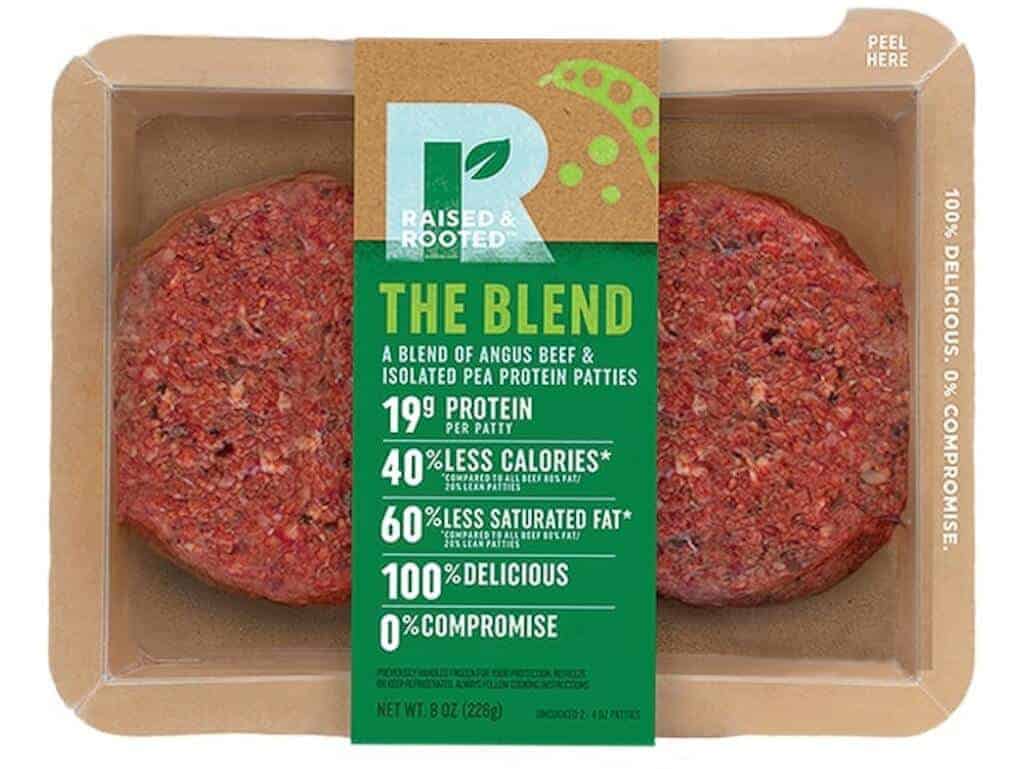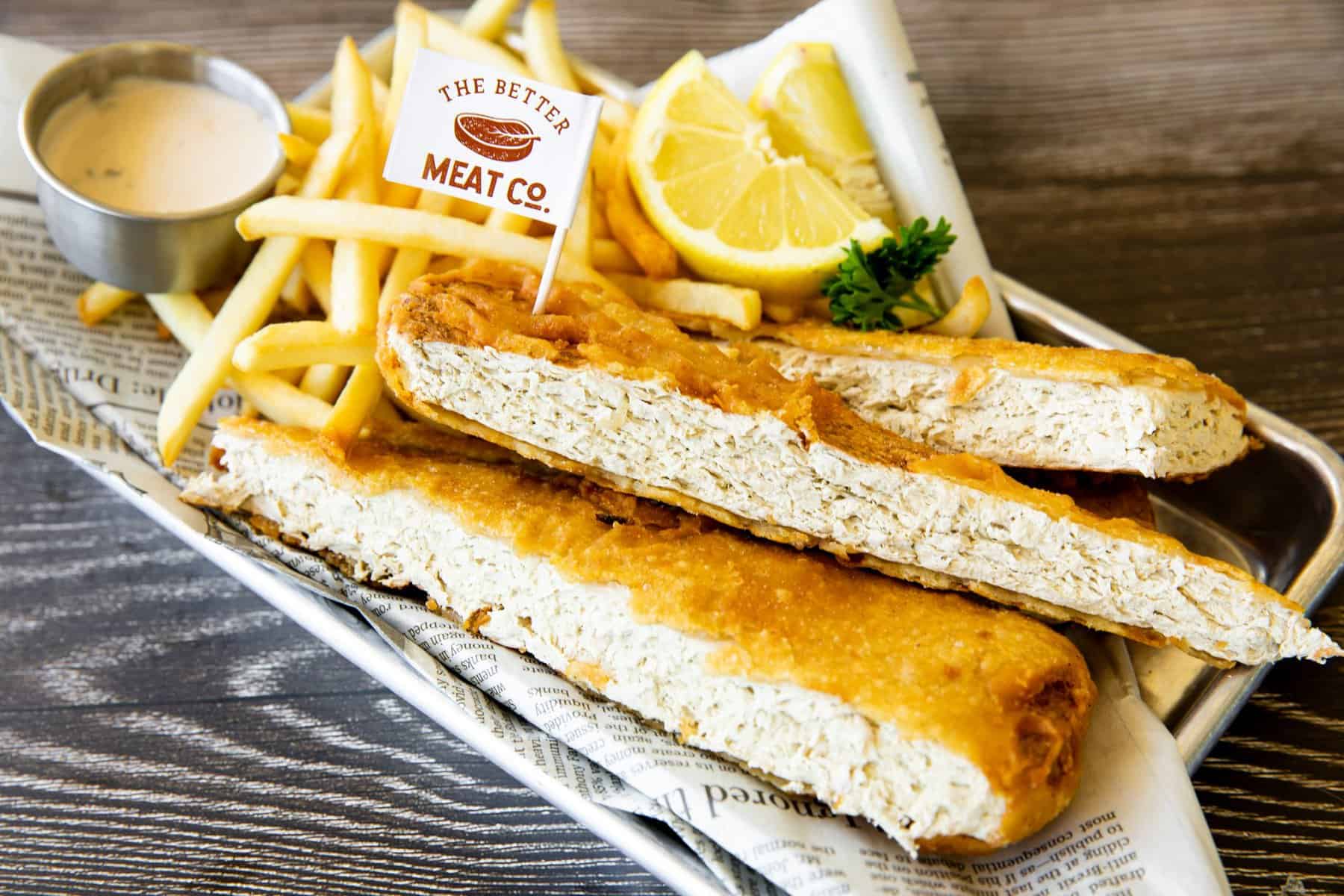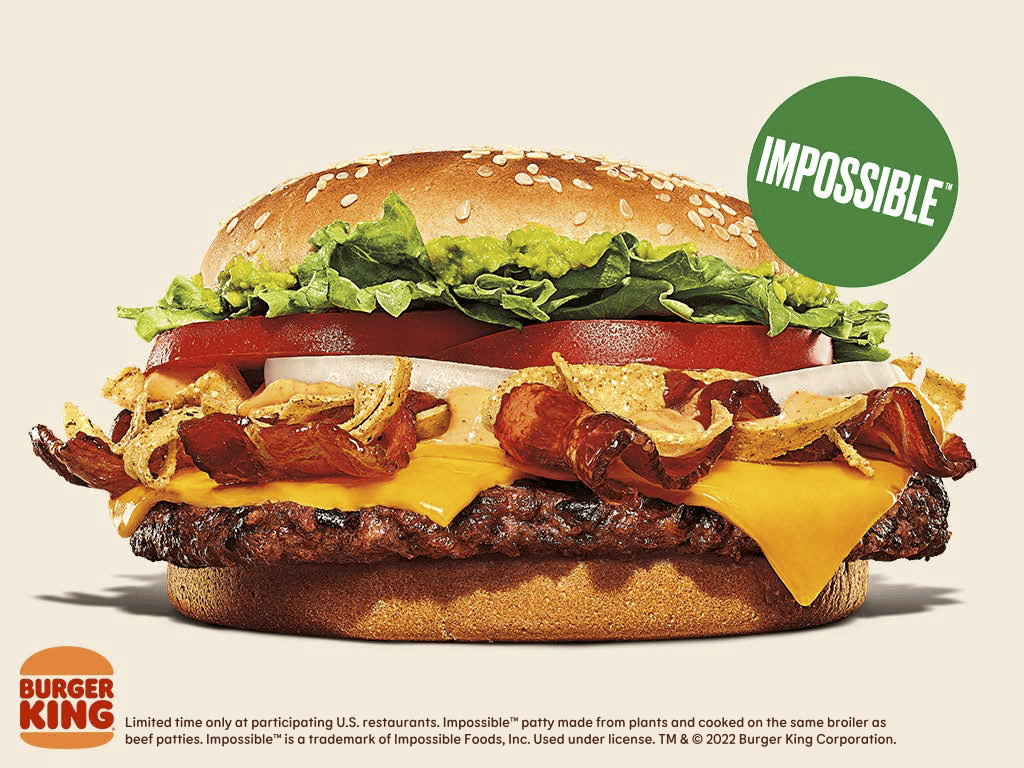From vegconomist.com
As Lidl Netherlands today announces the launch of a blended mince product containing 60% beef and 40% pea protein — which it claims generates 37.5% less CO2 than regular mince and is 33% cheaper — we take a deep dive into blended and hybrid products and compile responses and opinions from experts and producers of such products to examine what are they, who is making them and why, and for whom.
First things first: the definitions. “We tend to use the term ‘blended‘ to refer to products that are a mix of conventional and plant-based/ alt protein, and the term ‘hybrid‘ to refer to products that are a mix of cultivated meat with plant-based,” explains the GFI to vegconomist.
Protein of the future will look a little different
So, despite the fact that these terms are often used interchangeably, in industry terms, “blended” is an animal meat product — absolutely not for vegans but aimed at the omnivore — such as a burger or sausage that contains some vegetable or plant protein input. This is no new thing — meat extenders have been used in the food industry for many years.
Hybrids, on the other hand, are plant-based meat products that contain cultivated ingredients, and these will most likely take first prominence on the market in the format of plant-based burgers containing cultivated fat, since it offers enhanced organoleptic properties.
Examples of the above include: Swiss cultivated meat start-up Mirai Foods collaborated with Rügenwalder Mühle to develop hybrid alt meat products containing plant proteins and cultivated beef fat in 2022, and Spanish company Cubiq Foods, backed by US meat giant Cargill, also develops cultivated fat for plant-based alternatives.

Lidl commented today, “Not everyone wants to eat meat substitutes or legumes. By introducing a [blended] product, simply on the meat shelf, [Lidl] really appeals to the carnivore. They don’t even have to change their consumption patterns. This is a valuable addition that really gives Lidl the opportunity to influence the protein ratio.”
These blended meats then, are quite obviously not aimed towards the vegan consumer, however the first hybrid plant-based products that contain cultivated fats — created from cells and without the use of animals — are a novel food and as such will create rather a grey area; depending on their stance the vegan consumer may or may not choose to purchase hybrid meats.
Why, in a nutshell
Before we look at responses from producers and experts, we’ll briefly introduce the main reasons for the existence of these products in a nutshell.
Firstly, to reach environmental goals. “There is no way around hybrids, especially in the dairy industry, if companies want /need to reduce their Scope 3 emissions,” said a well-known producer of dairy products currently working on a hybrid product, who prefers to remain anonymous. This comment encapsulates one motivation and good reason for the existence of blended and hybrid meats – there’s no question that they offer environmental benefits to conventional meat.
“Many meat eaters aren’t ready to completely give up on their favourite dishes but are looking for ways to eat healthier and reduce their carbon footprint,” states ICL. “The solution is hybrid products that combine meat and plant-based ingredients that provide the flavour and texture consumers crave, with the healthfulness that they desire.”

Secondly, increased acceptance (which gives rise to more purchasing, and by proxy, further environmental benefits). According to the GFI, European consumers are open to trying blended meats with 25-50% plant content. A study found that a 70% meat and 30% mushroom blend was preferred in taste over various plant-based burgers in a blind test. Essentially, there is increased acceptance of alternative or plant protein among meat-eaters when a product comes in a familiar format.
According to an academic article published in Future Food on the subject of acceptance, “Blended meat products that are manufactured into formats that are familiar to consumers (such as burgers and nuggets) have increased rates of consumer acceptance due to reduced rates of food neophobia. If consumers of meat-based burgers and nuggets replace these products with blended meat analogues their meat consumption will reduce, and the perceived environmental and animal welfare impacts related to meat production would also reduce.
“Blended meat products therefore deliver a range of benefits for the consumer wishing to reduce meat consumption and also those who have become flexitarian for sustainability and animal welfare reasons,” state the authors.
Key players
Notable players in blended and hybrid meats at time of writing include:
- Choppy!, previously Paul’s Table, founded in 2023 by Saba Fazeli, the first R&D engineer at Beyond Meat. With the catchline, MADE WITH PLANT PROTEIN, BEEF TALLOW, BONE BROTH, & COLLAGEN, Choppy! has developed a fast-cooking, high-protein option that is mostly plant-based but “retains the taste and convenience of beef”.
- Famously, this June, Quorn’s Marlow Ingredients announced it will be supplying its mycoprotein product to be integrated into blended products that include animal meat for foodservice, including NHS hospitals.
- Tyson offers blended protein burgers made from beef and pea protein.
- 50/50 Foods – maker of the Both Burger. “Our mission is to cut meat consumption in half by delivering exceptional foods to the large and growing population of flexitarians. Our flagship burger, the BOTH Burger, is a game changer…it is the first and only USDA approved 50/50 burger (50% beef, 50% all-natural veggies) that is BOTH healthy and delicious, BOTH good for your heart and good for the planet.
- Mush Foods: creates “50 Cut, chef-curated multi-mycelium blends, offered in 6 varieties that pair with specific meat types. 50 Cut combines perfectly with meat, in both texture and taste creating great Umami flavour”.
- Nestle recently launched a customizable plant-based meat alternative called Maggi Rindecarne that consumers can add to minced meat, and is known as a “meat extender”.
- Hydrosol, solutions provider, last year entered hybrids. The German company said in a recent social media post, “Hybrid products of meat and vegetables are a perfect fit for a progressive society seeking more conscientious nutrition. They’re great for flexitarians who want to reduce their meat consumption without entirely sacrificing the enjoyment, and offer meat producers lucrative potential.”
- Perdue’s Chicken Plus range includes animal meats containing cauliflower, chickpeas and plant protein.
- The Better Meat Co (see below for founder statement) produces mycoprotein for blended meats.

We ask producers & experts – why blends & hybrids?
NOVAMEAT: They deliver perfect solution to flexitarians
Giuseppe Scionti, founder and CEO of Spain’s NOVAMEAT, explained to vegconomist: “We [Novameat] have believed in the flexitarian need for great food that just happens to be plant-based, since our beginnings. Brands need to deliver the same level of food experience as animal meat, but without the cost to our health or our planet; we are constantly perfecting our products for exactly this need.
“More than 66% of the UK are vegan, veggie or flexitarian because they are health or planet-conscious, or both. The majority of these consumers still want to eat meat on certain occasions but for the rest of their meals, they expect great taste and texture when it comes to alternatives, with the nutritional and sustainability quotas to match. If a new generation of plant-based products can deliver on all of these points, then they may well be the preferred choice for many consumers, as compared to animal or hybrid meats.”

ADM: A crucial role in the evolution of the protein landscape
Alicia Humpert, Marketing Director, Savory EMEA & Global Proteins, ADM, answered our question extensively. “The hybrid or blended protein market shows strong growth potential, and through the extension of our vast protein portfolio, footprint and capabilities across regions, we support our customers in diversifying their product offerings to capitalise on this opportunity.
“Hybrids and blended solutions serve as a bridge between the familiar and the new”
“Combining soy, pea and wheat proteins together or with wholesome ingredients, such as chickpea, beans or pulses, adds even more protein fortification, diversity, nutrient dense inclusion and multisensorial texture advantages along with ideal taste to plant-based blended products. Examples of consumer-preferred blended meat solutions include chicken nuggets, pulled pork, beef patties and more.
“Hybrids and blended protein options provide innovative solutions to achieve the familiar taste of meat, while increasing the amount of plant protein. The success of alternative proteins, including blended meat, highly depends on expectations for taste, texture and nutrition, as they drive consumer acceptance and adoption. Our recent research shows consumers see the benefits, citing “healthier,” “better for the environment,” “adding variety to diets,” “better dietary balance of plant and animal proteins” and “more nutritious” as key motivators for trying blends. Plus, 63% of global consumers find the concept of hybrid meat options appealing.

“We envision hybrid and blended meat products playing a crucial role in the evolution of the alternative protein landscape. Hybrids and blended solutions bridge the familiar and the new, facilitating consumer acceptance of novel proteins by offering a mix with well-known ingredients and formats, without drastically asking consumers to change their behaviour.”
QUORN: Meat reduction is not happening fast enough
Upon the the controversial recent news of Quorn / Marlow Foods’ blended products, CEO Marco Bertacca sent a statement including the following: “Over the last 20 years we, have seen Quorn’s consumer base expand to include flexitarians – a new type of consumer that actively tries to eat less meat, for both health and sustainability reasons.
“And this has resulted, in some more mature markets, in a reduction in the overall consumption of meat, which scientists agree would reduce global carbon emissions and help combat climate change. But that reduction is not happening fast enough, and with enough scale to have a meaningful impact, and so there is an urgent need to find new ways to reduce meat consumption.
“…the scale of the opportunity is huge”
“To that end, we are now working with our customers in the food-away-from-home sector to help them not just with meat-free menu items, but also those made from a blend of meat and Quorn, that can replace their 100% meat core menu items. This reduces the total amount of meat being eaten by their customers – helping tackle climate change and improve public health – while still delivering great-tasting food which people are familiar with.
“Serving food to millions of people every day, means the scale of the opportunity is huge. This will significantly reduce the carbon footprint of their menus, and so help them achieve their climate targets.”
THE BETTER MEAT CO: Sparing animals through meat
“Why not also be excited about it displacing animal meat in the meat itself?”
“Now imagine that in addition to the Impossible Whopper reducing beef demand by 2%, BK were also to make its conventional Whopper 25% plant-based. In this case, while it would be condemned as a half-measure (or a quarter measure) by some vegans, it would actually reduce beef demand dramatically more than offering the vegan option alone.

“In other words, in some scenarios hybridizing meat can help spare far more animals than vegan options alone. I remember how excited many animal advocates were 6-8 years ago when plant proteins started displacing animal meat in the meat aisle at supermarkets. Why not also be excited about it displacing animal meat in the meat itself?”
ProVeg – Significant climate emissions savings
“In the UK, in settings such as hospitals and schools, we can see this as a positive development. ProVeg UK’s School Plates programme sees it as a flexible and pragmatic move in settings where there are guidelines and restrictions on how much plant-based food you can serve. Based on research from the World Resources Institute, which encourages blended meat as a way to reduce climate emissions, ProVeg UK often advises school caterers to blend some meat dishes, typically with lentils, to make a dish healthier and more sustainable. It is estimated that UK schools serve 1.2 billion meals per year, and the NHS 200 million meals, so some blending can make very significant climate emissions savings each year.
“Pork, whether it is in a blended product or on its own, contributes to greenhouse gas emissions, as well as other environmental issues. So ProVeg advocates for a reduction in animal consumption and encourages companies and institutions to embrace more plant-based foods.”

VTT – Reinforcing food systems
Says research institution VTT, “Hybrid Food concept means combining food ingredients from diversified sources, such as animals, plants, cellular agriculture and fermentation, in an innovative way to produce high quality foods. Hybrid Food can simply mean combining animal origin ingredients with plant-based materials. As such it is not a novel concept, and already widely used by the food industry. In future, a stepwise reduction of meat consumption by hybrid, still meat-containing food products would presumably be an easy choice for both industry and consumers.
“Hybrid Foods provides a feasible approach to novel food ingredients to enter the market despite the scalability challenges. Thereby, instead of providing staple foods, cellular agriculture and fermentation -based ingredients will first be integrated into Hybrid Foods as high value compounds, which enables development of the business ecosystem and building infrastructure.
“Hybrid Foods concept enable the food system actors to reach the environmental goals faster. It can help the new start-ups with their business development and market uptake, but also generates new innovations. In the end, Hybrid Foods concept is about diversification of our food sources. By diversifying what we produce and eat, we cannot only reinforce our food systems but also align with the goals for a healthier, more sustainable, resilient, and equitable food system with minimized environmental consequences.”

There’s method to the madness
To summarise a complex and controversial subject that is multifaceted to say the least, let’s go back to 2020, when such products were first beginning to emerge. As Veronica Fil put it, “There is method to the madness here.
“These products address the phenomenon of loss aversion (the notion that people feel the impact of a loss much more than they would a gain of the same size). For example, the average consumer would not be happy if we took away half of the chicken nuggets on their dinner plate. A great deal of them would still not be happy, even if we replaced the missing nuggets with some delicious sautéed carrots—despite the obvious health, environmental and ethical benefits that would result. In this case, the feeling that something has been taken away from their plate far outweighs any perceived gain.
“That’s where a blended product can shine. It can steer consumers, who wouldn’t normally choose a vegan product, into making a better choice—without triggering that sense of loss. It’s also a bit like tricking adults into eating their vegetables.”
No comments:
Post a Comment